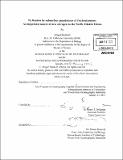N₂ fixation by subsurface populations of Trichodesmium : an important source of new nitrogen to the North Atlantic Ocean
Author(s)
Heithoff, Abigail
DownloadFull printable version (3.672Mb)
Alternative title
Nitrogen gas fixation by subsurface populations of Trichodesmium : an important source of new nitrogen to the North Atlantic Ocean
Other Contributors
Woods Hole Oceanographic Institution.
Advisor
Sonya T. Dyhrman.
Terms of use
Metadata
Show full item recordAbstract
Trichodesmium, a genus of diazotrophic cyanobacteria, is an important contributor to the marine nitrogen (N) and carbon (C) cycles. The extent to which Trichodesmium dinitrogen (N2) fixation contributes to the marine N cycle has been modeled based on abundance data and rate estimates from surface populations. However, recent data show that Trichodesmium populations have a broad vertical distribution. The presence of previously unaccounted for subsurface populations suggests that past estimates of the contribution of new N by Trichodesmium to the North Atlantic may be artificially low. Herein, culture and field studies were combined to examine trends in N2 fixation in discrete surface and subsurface Trichodesmium populations in the western North Atlantic. Surface populations were dominated by the raft colony morphology of Trichodesmium and surface N2 fixation rates ranged from (33 to 156 μmol h-1 mol C-1). Subsurface populations were dominated by the puff colony morphology. Subsurface N2 fixation was typically detectable, but consistently lower than surface population rates (9 to 88 μmol h-1 mol C-1). In an analysis of the entire field dataset, N2 fixation rates varied non-linearly as a function of in situ irradiance. This trend in N2 fixation versus in situ irradiance is consistent with field and culture observations in the literature (Bell et al., 2005; Capone et al., 2005), however other models that predict N2 fixation based on light predict higher subsurface N2 fixation than what was detected in this study. In culture, N2 fixation in Trichodesmium was proportional to light level over the range of irradiances tested (10 to 70 μmol quanta m-2 s-1) and over long and short time scales, suggesting subtle changes in the light field could depress subsurface N2 fixation. Since the subsurface samples were dominated by the puff colony morphology, it is unclear if the subsurface N2 fixation rates are the result of the in
Description
Thesis (S.M.)--Joint Program in Oceanography/Applied Ocean Science and Engineering (Massachusetts Institute of Technology, Dept. of Biology; and the Woods Hole Oceanographic Institution), 2011. Cataloged from PDF version of thesis. "February 2011." Includes bibliographical references (leaves 44-48).
Date issued
2011Department
Joint Program in Oceanography/Applied Ocean Science and Engineering; Massachusetts Institute of Technology; Woods Hole Oceanographic Institution; Massachusetts Institute of Technology. Department of BiologyPublisher
Massachusetts Institute of Technology
Keywords
Joint Program in Oceanography/Applied Ocean Science and Engineering., , Woods Hole Oceanographic Institution.